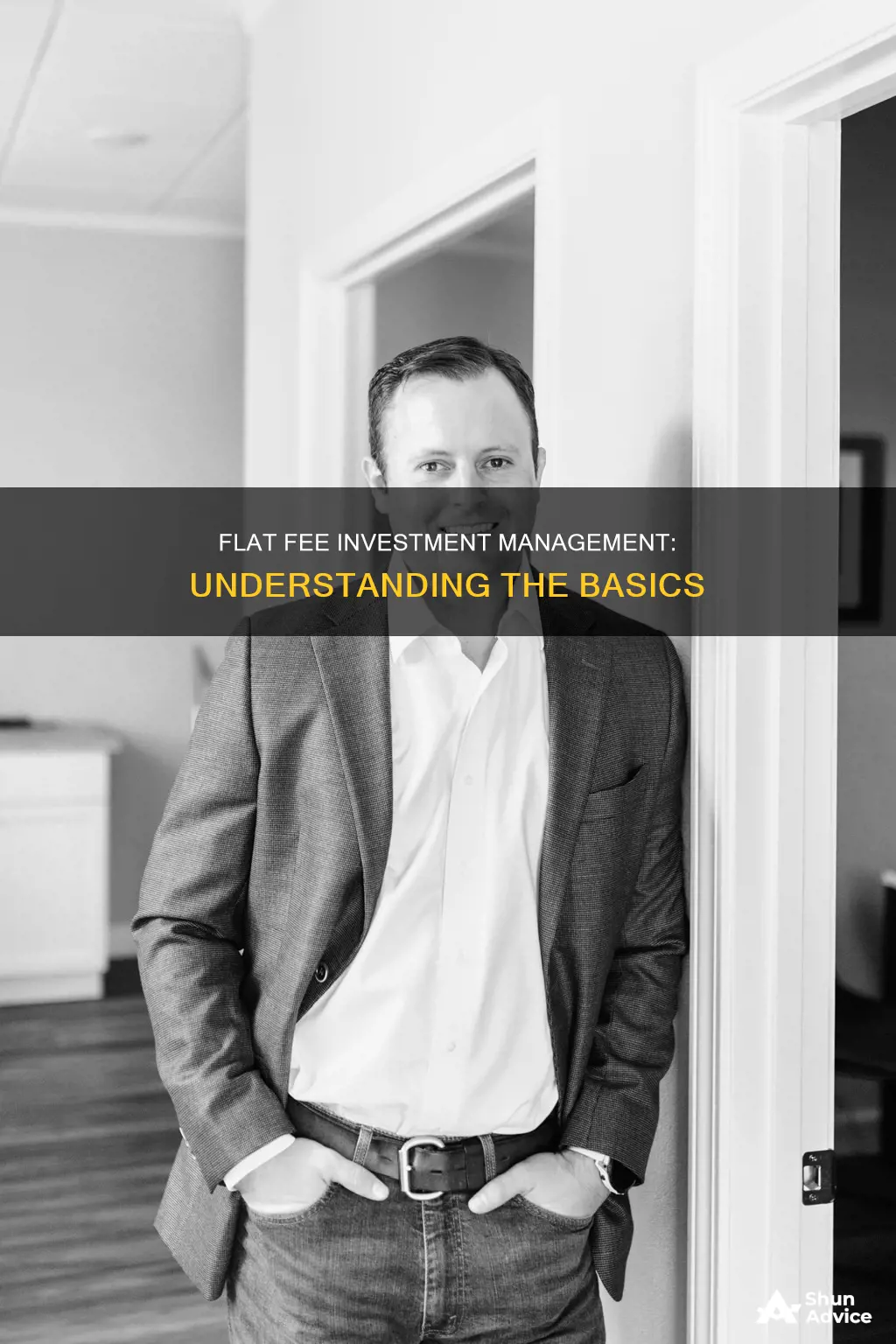
Flat-fee investment management is a type of financial advisory service where clients pay a fixed rate that is often billed quarterly, regardless of their assets. This fee structure provides full transparency without the worry of additional or increasing fees as finances evolve. Flat-fee advisors charge a single fee based on the complexity of the client's situation, not the amount of money they have. This eliminates potential conflicts of interest, as advisors are not incentivised by commissions from product sales. Flat-fee structures are typically billed annually, monthly, or quarterly for ongoing financial planning services and can be ended by the client at any time.
| Characteristics | Values |
|---|---|
| Definition | Flat-fee investment management involves paying a fixed rate for investment management services, regardless of your assets. |
| Comparison to traditional models | Flat-fee investment management is an alternative to traditional pricing models, such as paying a percentage of the value of the portfolio managed by the advisor. |
| Benefits | Flat-fee investment management can save clients thousands of dollars each year compared to paying a percentage of assets, especially as net worth grows. It also offers greater transparency and control over fees, and does not increase when the market goes up or when you add to your investment account. |
| Fee calculation | The flat fee may be calculated based on income, portfolio size, and/or the complexity of individual circumstances. |
| Service inclusions | Flat-fee investment management may include creating a detailed financial plan for debt, goals, investments, etc. Some advisors may also implement the investment plan on the client's behalf. |
| Service duration | Flat-fee investment management can be a one-time service or an ongoing, long-term relationship. |
| Fee payment | The flat fee is often billed quarterly and can be paid directly to the advisor or taken from the client's accounts. |
| Fee range | Flat-fee investment management fees can range from $1,000 to $10,000 per year or more, depending on the scope and detail of the financial plan, whether investment management is involved, and the complexity of the client's circumstances. |
| Suitable for | Flat-fee investment management is ideal for affluent clients with larger asset balances above $1 million who seek ongoing investment management and planning in retirement. |
| Potential drawbacks | Flat-fee investment management may be more expensive than other models for clients with smaller portfolios. Flat-fee advisors may also need to partner with outside professionals to implement certain products, such as insurance. |
What You'll Learn

Flat-fee financial advisors charge a fixed rate, regardless of your assets
Flat-fee financial advisors are an alternative to traditional pricing models, which typically charge a percentage of the value of the client's portfolio or assets under management (AUM). With a flat-fee structure, clients pay a fixed rate regardless of their assets. This means that the fee is not based on how much the client has invested, but rather on the services provided and the advisor's expertise. Flat fees are often billed annually, quarterly, or monthly, and clients can usually end the arrangement whenever they choose.
The flat-fee model offers several benefits. Firstly, it provides a more direct link between the fee charged and the services provided, increasing transparency and reducing potential conflicts of interest. When advisors are compensated through a percentage of AUM, their advice may be influenced by the desire to maximise their revenue. In contrast, flat-fee advisors have no incentive to encourage clients to invest more, as their compensation is not tied to the size of the client's assets. This can result in more objective and unbiased advice. Additionally, flat fees can be more predictable and easier to track, as clients know exactly how much they will be paying in advance.
The cost of hiring a flat-fee financial advisor can vary depending on factors such as the scope and complexity of the services provided, the advisor's experience and location, and the client's individual circumstances. Fees can range from a few hundred dollars for a one-time meeting to tens of thousands of dollars for complex management and planning services. Some flat-fee advisors may also offer different tiers of service, with higher fees for more comprehensive planning. It is important for clients to understand exactly what services are included in the flat fee and whether any additional costs may be incurred.
While flat-fee advisors can provide greater transparency and reduce conflicts of interest, there may be situations where this model is not the most suitable option. For example, flat-fee structures may not always be the most cost-effective, especially for clients with smaller accounts or those who only require a one-off engagement. In such cases, an hourly or percentage-based fee structure might be more appropriate. Additionally, flat-fee advisors may need to partner with outside professionals to implement certain commissionable products, such as insurance, which could result in additional fees for the client.
Ally Invest: Portfolio Margin Trading Options Explored
You may want to see also

Flat-fee structures can be one-time, ongoing, or a combination of both
Flat-fee structures are highly flexible and can be tailored to meet the needs of the client. Flat fees can be charged as a one-time payment, an ongoing fee, or a combination of both.
A one-time flat fee is typically charged for a time-limited project or engagement, such as a retirement projection or a one-time meeting with a financial advisor. This structure is ideal for clients who only require advice or planning for a specific, one-off event.
On the other hand, ongoing flat fees are charged at regular intervals, such as annually, monthly, or quarterly, for continuous financial planning services. This structure is suitable for clients seeking long-term relationships with their financial advisors and ongoing investment management and planning. The fees are often billed quarterly, and clients can usually terminate the arrangement if their needs change.
In some cases, financial advisors may offer a combination of both one-time and ongoing flat fees. For instance, clients may be charged a one-time fee for a specific project and an additional ongoing fee for investment management and financial planning services. This hybrid structure allows for customisation and flexibility to meet the diverse needs of clients.
The flat-fee model provides transparency and predictability in pricing. Clients know in advance how much they will be charged and can easily track their expenses. Additionally, flat fees are typically based on the complexity of the client's situation rather than the amount of assets they have, ensuring a fair and unbiased fee structure.
Investment Manager: A Career in Finance and Management
You may want to see also

Flat-fee models reduce conflicts of interest
Flat-fee investment management involves paying a fixed rate for investment advice and services, regardless of the size of your assets. This model has gained popularity as an alternative to traditional pricing structures, such as paying a percentage of the value of your portfolio or assets under management (AUM).
For example, if a client is considering paying off their mortgage, buying property, or giving money away, a flat-fee advisor will not be concerned about losing revenue. Their advice will not be influenced by the potential for a ''pay cut'' if the client's assets decrease. This promotes transparency and ensures that the advisor's recommendations are based on what is best for the client, rather than their own financial interests.
Additionally, flat-fee advisors are often fee-only advisors, meaning they do not accept commissions for selling financial products. This further reduces conflicts of interest and ensures that the advisor's loyalty lies solely with their client.
The flat-fee structure also provides clients with greater predictability and control over their fees. Clients know in advance how much they will be paying and can easily track expenses, as the fees are typically billed at regular intervals. This transparency allows clients to make informed decisions about the cost-effectiveness of the service.
While flat-fee models have numerous benefits, it is important to note that they may not be suitable for everyone. In some cases, flat-fee structures may be more expensive than traditional percentage-based fees, especially for clients with smaller asset pools. Additionally, flat-fee advisors may have limited involvement in investment management, leaving certain tasks, such as trading and rebalancing, to the client.
Overall, flat-fee investment management offers a transparent and conflict-free alternative to traditional pricing models. By removing the link between compensation and asset size, flat-fee advisors can provide unbiased advice and services that prioritise their clients' interests.
Savings: Exploring Investment Options Beyond Fixed Deposits
You may want to see also

Flat-fee advisors do not sell products or receive commissions
Flat-fee advisors are not influenced by commissions or the sale of financial products. This means they are not incentivised to recommend certain products or services to their clients, and are therefore less likely to be biased. Flat-fee advisors are also known as fee-only advisors, and they are compensated solely by what they charge their clients directly, rather than by commissions from product sales.
The flat-fee model is beneficial for clients as it ensures transparency and no hidden charges. Clients know exactly what they are paying for and how much they will be charged, as the fee is agreed upon in advance. This model also reduces conflicts of interest, as the advisor's compensation is not tied to the client's assets under management (AUM).
Flat-fee advisors are legally required to act in their clients' best interests and to disclose any potential conflicts of interest. They are held to a higher standard than commission-based advisors, who are only required to make "suitable" recommendations rather than "best-interest" ones.
The flat-fee structure also provides predictability for both advisors and clients, as the fees remain the same regardless of market fluctuations or changes in the client's financial situation. This can be particularly advantageous for clients with complex financial situations or those seeking long-term investment management and planning.
While flat-fee advisors do not sell products, they may partner with outside professionals to implement certain products, such as insurance. In such cases, additional fees may be charged by these external partners. It is important to note that flat-fee advisors may have limited product and service offerings, and their fees can sometimes be more expensive compared to commission-based advisors.
Investing Wisely: The Importance of a Diverse Portfolio
You may want to see also

Flat-fee financial advice is gaining momentum
The financial services industry is evolving, and with it, the way financial advisors are paid for their services. Traditionally, financial advisors were paid via commissions, but now, flat-fee financial advice is gaining traction and is an excellent option for some.
Flat-fee financial advice involves paying a fixed rate for financial advisory services, regardless of your assets. The cost depends on the services provided and the advisor's expertise, and you know how much you'll pay in advance. This can be an annual, monthly, or quarterly charge for ongoing financial planning services, or a one-time fee for a time-limited project, such as a retirement projection.
Benefits of Flat-Fee Advice
Flat-fee advice offers a more direct link between the fee charged and the services provided, reducing problems related to asset-based charges. It also provides transparency and predictability, as you agree on the cost before engaging with an advisor, and there are no hidden or increasing fees as your finances evolve.
Additionally, flat-fee advisors are often fee-only advisors, meaning they do not accept commissions for selling financial products, reducing conflicts of interest and promoting transparency. When compensation is not tied to assets under management, advisors may be more objective and less likely to discourage financially beneficial decisions for the client, such as paying off a mortgage or buying a vacation home.
Potential Drawbacks
While flat-fee advice can be beneficial, it may not always be the most suitable option. In certain situations, it may end up being more expensive than working with a fee-based or commission-based advisor, especially for those with smaller accounts or simpler financial needs.
Furthermore, flat-fee financial advisors may focus solely on providing advice and not get involved in investment management, leaving the client to handle trading, rebalancing, and day-to-day management.
Finding a Flat-Fee Advisor
When looking for a flat-fee financial advisor, it's important to understand the services offered and how the fee is calculated. Flat-fee advisors can be found through fee-only advisor directories, such as XY Planning Network and NAPFA, or through online searches using terms like "fee-for-service." It's crucial to research their background, regulatory history, and credentials to ensure they are a good fit for your needs.
The PVF Savings Investment: A Smart Financial Move
You may want to see also
Frequently asked questions
A flat-fee investment management service charges a fixed rate that you pay regardless of your assets. The fee is based on the complexity of your situation, not the amount of money you have.
Flat-fee investment management services offer increased transparency and help to reduce conflicts of interest. They also provide a more direct link between the fee being charged and the services provided.
The cost of a flat-fee investment management service varies depending on the service provided and the advisor's expertise. Fees can range from a few hundred dollars to tens of thousands of dollars per year.







